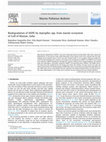Papers by Dr. Nivas Duraisamy

Bacterial diseases have serious impacts on agricultural food production. Several methods are avai... more Bacterial diseases have serious impacts on agricultural food production. Several methods are available to control these phytopathogens, including antibiotics and copper sprays. However, bacterial resistance to antibiotics makes it risky to continue those strategies and highlights the need for effective disease-control agents. An alternative option is the use of lytic phages to control phytopathogens. Phages are in vivo anti-phytopathogenic isolates that can be used for in vitro biocontrol. In some circumstances, increased phage disease-control efficiency, protective formulations, appropriate application timings, and integrated management strategies can be achieved. The use of phages in plant disease control is a compelling topic, and several successful studies have been done on phytopathogens. In this chapter, we explore the use of phages in plant-disease control and their roles in the development of effective biocontrol agents.
Objective: To isolate. Screen and characterize an effective phage for MDR and ESBL producing path... more Objective: To isolate. Screen and characterize an effective phage for MDR and ESBL producing pathogenic bacterial strains.

Despite enormous progress in agro science technology, considerable limitations remain due to the ... more Despite enormous progress in agro science technology, considerable limitations remain due to the biological systems in question, the disadvantages of managing balanced activities with other organisms, and the inevitability of compromising quality or quantity. Implementations of new technologies such as agrochemicals have led to reductions in soil fertility and in native microflora and -fauna (including non-target organisms). Agrotraditional practices, which provide precious methods for controlling the diseases spread by plant pathogenesis, enhancing the advantages, and enriching soil fertility. The methods implemented directly or indirectly by traditional farmers are effective and reliable in controlling plant pathogens in storage places and in increasing crop yields. This chapter examines traditional plant pathogenic control strategies implemented by the ancients and presently adopted in ongoing practices.

HDPE Aspergillus tubingensis VRKPT1 Aspergillus flavus VRKPT2 Fourier transformed infra-red spect... more HDPE Aspergillus tubingensis VRKPT1 Aspergillus flavus VRKPT2 Fourier transformed infra-red spectroscopy Scanning electron microscopy a b s t r a c t High density polyethylene (HDPE) is the most commonly found non-degradable solid waste among the polyethylene. In this present study, HDPE degrading various fungal strains were isolated from the polyethylene waste dumped marine coastal area and screened under in vitro condition. Based on weight loss and FT-IR Spectrophotometric analysis, two fungal strains designated as VRKPT1 and VRKPT2 were found to be efficient in HDPE degradation. Through the sequence analysis of ITS region homology, the isolated fungi were identified as Aspergillus tubingensis VRKPT1 and Aspergillus flavus VRKPT2. The biofilm formation observed under epifluorescent microscope had shown the viability of fungal strains even after one month of incubation. The biodegradation of HDPE film nature was further investigated through SEM analysis. HDPE poses severe environmental threats and hence the ability of fungal isolates was proved to utilize virgin polyethylene as the carbon source without any pre-treatment and pro-oxidant additives.

Uploads
Papers by Dr. Nivas Duraisamy